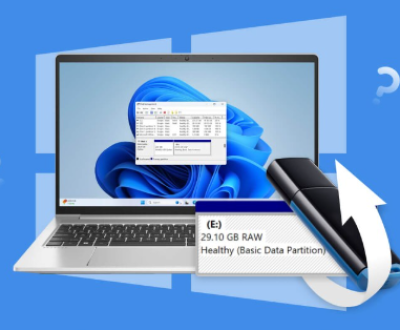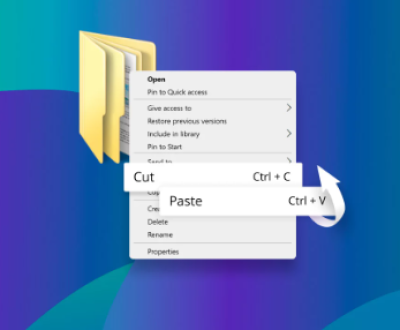External hard drives have become essential tools for storing and backing up large amounts of data. Whether it’s for personal use, professional work, or as a backup solution, external hard drives offer convenient and portable storage options. However, despite their reliability, users sometimes face the frustrating issue of losing data stored on these drives. This can happen for various reasons, such as accidental deletion, corruption, or hardware failure.
Chapter 1: Understanding Data Loss on External Hard Drives
Before jumping into the recovery process, it’s crucial to understand why data loss occurs. Several factors contribute to the loss of files on an external hard drive:

1.1. Accidental Deletion
One of the most common reasons for data loss is accidental deletion. This could be deleting files or folders by mistake, or even emptying the Recycle Bin without realizing that important files are still in it.
1.2. File System Corruption
External hard drives are prone to file system corruption due to improper ejection, physical damage, or power outages during data transfers. Corruption can result in unreadable or inaccessible files.
1.3. Physical Damage
External hard drives can be damaged physically due to impacts, drops, or exposure to elements such as water or extreme temperatures. Physical damage can cause failure in the drive’s internal components, making data recovery more difficult.
1.4. Virus or Malware Attack
External drives can be infected with malware or viruses, which may corrupt files or make them inaccessible. The virus can also delete files, further complicating the recovery process.
1.5. Formatting the Drive
Sometimes, users may accidentally format the external hard drive. Formatting erases the data and can make it difficult to retrieve files. However, with the right tools and methods, it’s still possible to recover formatted data.
1.6. Logical Failures
A logical failure refers to software-related issues that prevent the drive from being detected or the files from being accessed. This could be due to corrupted partition tables, missing or damaged system files, or incorrect driver installations.
Chapter 2: Preparing for File Recovery
Before you begin the recovery process, it’s important to prepare the external hard drive and your system to avoid further complications during the recovery.
2.1. Stop Using the External Hard Drive
Once you realize that data is missing or corrupted on your external hard drive, it is critical to stop using it immediately. Continued use may overwrite the deleted or corrupted files, making them harder to recover.
2.2. Check the Connection
Ensure that the external hard drive is properly connected to your computer. Sometimes, the issue could be as simple as a loose cable or a faulty USB port. Try connecting the drive to another port or using a different cable to see if the issue is with the connection.
2.3. Run Diagnostics
If your external hard drive is not recognized or is making unusual sounds (like clicking), it could indicate a physical issue. In such cases, consider running diagnostics on the drive to assess the condition of the hardware before attempting recovery.
Chapter 3: Recovery Methods for Different Types of Data Loss
Depending on the cause of the data loss, you may need to choose different recovery methods. Let’s explore the most common scenarios and how to address them:
3.1. Recovering Deleted Files
If you accidentally deleted files or formatted your external hard drive, the first step is to check the Recycle Bin on your computer. Files that are deleted from an external hard drive may sometimes end up in the Recycle Bin if the drive is connected when the deletion occurs.
Step 1: Use File History (Windows)
For users of Windows, File History might have automatically backed up your files. To restore files from File History:
Open the folder where the files were located.
Right-click and select Restore previous versions.
Choose a version of the folder before the deletion occurred.
Step 2: Use Time Machine (Mac)
Mac users can rely on Time Machine for file recovery. If Time Machine was enabled:
Go to the folder where the files were located.
Open Time Machine by clicking the Time Machine icon in the menu bar.
Browse through the timeline to find the files you want to restore.
Click Restore to recover the files.
3.2. Recovering Files from a Corrupted or Unreadable Drive
When your external hard drive is corrupted or shows up as unreadable, you may need to use recovery software. Popular options for data recovery include:
Panda Assistant supports a variety of file systems, including NTFS, FAT, exFAT, HFS+, and APFS, making it compatible with both Windows and macOS. This versatility allows users across different platforms to recover their data with ease.
Additionally, Panda Assistant can help you recover data from formatted drives or partitions, providing a solution even in scenarios where data seems permanently lost. The software is designed to be as non-invasive as possible, ensuring minimal risk to your data during the recovery process.
For anyone looking to retrieve lost or deleted files from their computer or external storage, Panda Assistant is an invaluable tool, offering an effective and straightforward solution for data recovery.
Step 1: Download and Install Recovery Software
Download a reliable recovery program on your computer (preferably on a different drive to avoid overwriting data on the external hard drive).
Install and run the program, selecting the external hard drive as the target location for recovery.
Step 2: Scanning the Drive
Start a scan of the external hard drive to search for lost or corrupted files.
Choose a deep scan if the regular scan does not return the desired results. Deep scans are slower but more thorough, identifying files that might have been overlooked in a quick scan.
Step 3: Preview and Recover Files
After the scan is complete, the software will list recoverable files.
Preview the files to ensure they are intact and recoverable.
Select the files you want to recover and choose a safe location (preferably on a different drive) to store the recovered files.
3.3. Recovering Data from a Physically Damaged Drive
In cases of physical damage, such as clicking or grinding noises, it is recommended to avoid using DIY recovery methods. Attempting recovery on your own could worsen the damage and make the data irretrievable. Instead, seek professional help from data recovery services.
3.4. Recovering Files from a Formatted Drive
If the external hard drive was formatted, the data may not be lost permanently. Even after a format, the file system is typically marked as empty, but the data remains on the drive until overwritten.
To recover files from a formatted external hard drive, you can follow the same procedure as for a corrupted drive using recovery software like EaseUS or Recuva. Simply choose the external drive, scan it for deleted files, and recover the files to a safe location.
Chapter 4: Using Command-Line Tools for Data Recovery
For users with technical experience, command-line tools can be a powerful option for recovering lost files from external hard drives.
4.1. Using CHKDSK on Windows
CHKDSK (Check Disk) is a built-in Windows tool that can help fix file system errors on external hard drives. It won’t recover deleted files but can repair a corrupted drive to make the data accessible again.
To run CHKDSK:
Open Command Prompt as an administrator.
Type the command: chkdsk X: /f (Replace “X” with the letter of your external drive).
Press Enter to run the tool and allow it to fix any errors.
4.2. Using TestDisk for Data Recovery
TestDisk is a powerful, open-source tool designed for recovering lost partitions and making non-booting disks bootable again. It works by scanning the drive for lost partitions and repairing the file system.
Step 1: Download TestDisk
Download and install TestDisk on your computer.
Step 2: Run TestDisk
Open the program and select the external hard drive.
Follow the on-screen instructions to scan and repair the partition structure.
Chapter 5: Tips to Prevent Data Loss in the Future
While data recovery is possible, prevention is always better than cure. Here are some tips to avoid losing data in the future:
5.1. Regular Backups
Always back up your data regularly. Use a combination of cloud storage and external hard drives for comprehensive protection. Set up automated backup systems to ensure your data is always safe.
5.2. Use Reliable Antivirus Software
Ensure that your external hard drive is free from viruses and malware. Always scan your external drive with up-to-date antivirus software before accessing it.
5.3. Properly Eject External Drives
Always eject your external hard drive safely before disconnecting it from the computer. Improper ejection can lead to file system corruption and data loss.
5.4. Monitor Drive Health
Use disk monitoring software to track the health of your external hard drive. Programs like CrystalDiskInfo can provide insights into the drive’s condition, helping you detect potential issues early.
About us and this blog
Panda Assistant is built on the latest data recovery algorithms, ensuring that no file is too damaged, too lost, or too corrupted to be recovered.
Request a free quote
We believe that data recovery shouldn’t be a daunting task. That’s why we’ve designed Panda Assistant to be as easy to use as it is powerful. With a few clicks, you can initiate a scan, preview recoverable files, and restore your data all within a matter of minutes.
Subscribe to our newsletter!
More from our blog
See all postsRecent Posts
- Retrieve files from usb 2025-07-04
- How to retrieve overwritten excel file 2025-07-04
- How to retrieve lost files on sd card 2025-07-04

 Try lt Free
Try lt Free Recovery success rate of up to
Recovery success rate of up to









